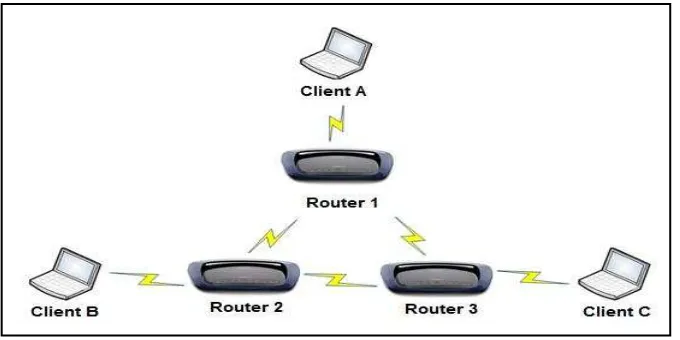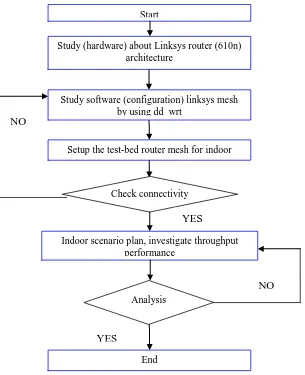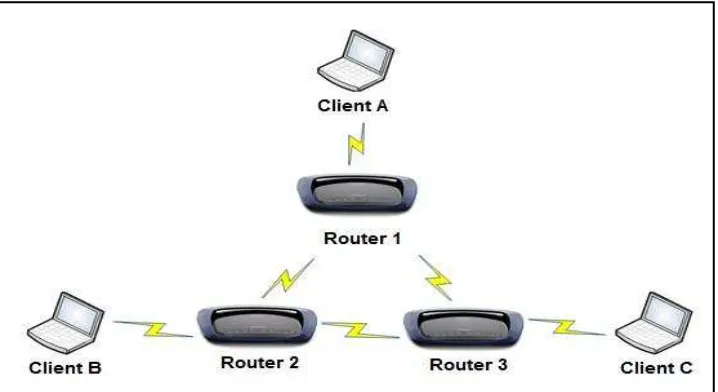ii
DEPLOYMENT OF MESH AND MULTIHOP WIRELESS NETWORK FOR INDOOR SCENARIO
MOHD KHAIRUL AMRI BIN AROM
This Report Is Submitted In Partial Fulfillment of Requirements for the Bachelor Degree of Electronic Engineering (Wireless Communication) With Honours
Fakulti Kejuruteraan Elektronik dan Kejuruteraan Komputer Universiti Teknikal Malaysia Melaka
iv
―I hereby declare that this report entitles Deployment Of Mesh and Multihop
Wireless Network for Indoor Scenario is result of my own work except as cited clearly in the references.‖
Signature : ...
v
―I hereby declare that I have read this report and in my opinion this report is
sufficient in term of the scope and quality for the award of the Bachelor Degree of
Electronic Engineering (Wireless Communication) With Honours.‖
Signature :………...
Supervisor Name : Cik Aisah Binti Junos @ Yunus
vi
Specially dedicated to
My beloved parents, brother, sister and my lover who have encouraged, guided and inspired me throughout my journey of education
vii
ACKNOWLEDGEMENT
viii
ABSTRACT
This project is about deploying a Mesh and Multihop Test-bed wireless network for indoor scenario. This test-bed using off-the-shelf equipments are Linksys WRT610n V2 Router and dd-wrt firmware. Usually LAN is a normal technology that used to create the network by using a lot of wire but this project used the technology of wireless as a medium communication and it will be reduced the cost of installation. The performance of throughput is evaluated between mesh and multihop to extend the LAN network coverage by using wireless technologies. Then, the performance of TCP and UDP throughput is investigated for mesh and multihop wireless network in indoor scenario. This project has been done successful for test bed performance for each router which has been located at multilevel FKEKK building. Lastly, from the analysis network performance, the results shown that mesh is better than multihop in term of stability and throughput for each router before deploy in real environment.
ix
ABSTRAK
x
TABLE OF CONTENT
CHAPTER TITLE
PAGE
PROJECT TITLE i
CONFESSION ii
DEDICATION v
ACKOWLEDGEMENT vi
ABSTRACT vii
ABSTRAK
viii
TABLE OF CONTENT ix
LIST OF TABLE xii
LIST OF FIGURE
xiii
LIST OF ABBREVIATION xv
I INTRODUCTION 1
1.1 Background project 1
1.2 Objectives Project 3
1.3 Problem Statement 3
1.4 Scope of Project 4
xi
1.5.1 Flowchart description 5
1.6 Report Outline 6
II BACKGROUND RESERACH 7
2.1 Wireless Mesh Network 7
2.1.1 Advantage Wireless Mesh Network 9
2.2 Multihop Wireless Network 11
2.2.1 Wireless Mesh and Multihop Node and
Access Point 13
2.3 The architecture of Mesh and Multihop 13 2.3.1 Infrastructure/Backbone Mesh and Multihop 13 2.3.2 Client Mesh and Multi hop 14 2.3.3 hybrid mesh and multi hop 14 2.4 Comparison Between Mesh and Multi hop 14
2.5 Router Architecture 15
2.6 Features of Router 17
2.6.1 Double Bandwidth 17
2.6.2 Extended Coverage 17
2.6.3 Giga byte Connectivity 17
2.6.4 Advance Security 17
2.7 Sofware 18
2.8 Network Performance Internet Protocol 19 2.8.1 Transmission Control Protocol 19
2.8.2 Users Data Protocol 19
2.8.3 Frame Structure 20
2.9 Throughput 21
2.9.1 Channel Selection 22
2.9.2 Impact of Channel Interference 23 2.9.3 Method to Avoid Interference 24
2.9.3.1 Analyze the potential for
xii
sources from operating 24 2.9.3.3 Provide adequate wireless
LAN coverage 24
2.9.3.4 Set configuration parameters properly 24 2.9.3.5 Deploy the newer 802.11a
wireless LANs. 25
III PROJECT METHODOLOGY 26
3.1 Pre-Deployment Part of Test bed 26 3.1.1 Firmware and Hardware Setting 27
3.2 Flow chart description 27
3.2.1 Installing DD-WRT 28
3.2.2 Software Setting 33
3.3 Test-bed Deployment Part 35
3.3.1 Test Bed Setup 35
3.3.2 Test-bed location 36
IV RESULT AND ANALYSIS 38
4.1 Result 38
4.1.1 Wireless Mesh Network 39
4.1.2 Multihop Wireless Network 41
4.2 Analysis 46
V CONCLUSION AND FUTURE WORK 47
5.1 Conclusion 47
xiii
5.2.1 Improvements to the indoor conditions. 48 5.2.2 Refinement of experimental parameter 48
REFERENCES 49
xiv
LIST OF TABLES
NO TITLE PAGE
2.1 Comparison mesh and multihop 14
2.2 Features of router 15
xv
LIST OF FIGURES
NO TITLE PAGE
1.1 Wireless Mesh Network Topology 2
1.2 Multi hop Wireless Network 2
1.3 Flow Chart Wireless Mesh Network 5
2.1 Wireless mesh network topology 8
2.2 Wireless Mesh Network Architecture 9
2.3 Multi hop wireless network topology 11 2.4 A multi-hop ‗mesh‘ wireless network 12
2.5 Omni-directional Antenna coverage 13
2.6 Linksys WRT610n 15
2.7 Basic Router Architecture 16
2.8 TCP frame structure 20
2.9 UDP frame structure 20
2.10 Channel bandwidth 21
2.11 Channel Overlap for 802.11b 22
3.1 Router database 28
3.2 Upgrade firmware 29
3.3 Set the channel frequencies 30
3.4 WDS MAC Address Setup 31
3.5 Set IP address 32
3.6 Signal quality 32
3.7 CMD 33
xvi
3.9 Average throughput 34
3.10 Layout of mesh and multi hop FKEKK indoor building 35
3.11 Test-bed Method 36
3.12 Layout of mesh 36
3.13 Layout of Multi hop 37
4.1 Throughput for Mesh Router 1 39
4.2 Throughput for Mesh Router 2 39
4.3 Throughput for Mesh Router 3 40
4.4 Throughput for Multihop Router 1 41
4.5 Throughput for Multihop Router 2 41
4.6 Throughput for Multihop Router 3 42
4.7 Mesh Average Throughput 43
4.8 Multihop Average Throughput 43
xvii
LIST OF ABBREVIATIONS
WMN - Wireless Mesh Network LAN - Local Area Network MAN - Metropolitan Area network IP - Internet Protocol
DRAM - Dynamic Random Access Memory PDA - Personal Digital Assistance
TV - Television
OLSR - Optimized Link State Routing
1
CHAPTER I
INTRODUCTION
This chapter will be explain about the background of project, objective of project, problem statement, scope of project, methodology and report outline.
1.1 Background Project
The purpose of this project is to research and deploy a mesh and multihop wireless network to extend the coverage using Linksys WRT 610n V2. This router provided dual band frequencies 5GHz and 2.4GHz. This project deploys for indoor environment with investigating the performance between two types of this network.
A wireless mesh network is a communication network made up of radio nodes organized in a mesh topology as shown in Figure 1.1. Every router can communicate each other in multiple paths. This method is used as backup network in case one of the routers is down and the network is still communicated. Similar with mesh, multihop is part of mesh wireless network whereby every router connected to another router in single path as shown in Figure 1.2.
2
Figure 1.1: Wireless Mesh Network Topology
Figure 1.2: Multihop Wireless Network
[image:18.595.153.489.376.528.2]3
1.2 Objectives
The objectives of the project are to:
i. create a 802.11 mesh and multihop wireless network test-bed using equipments Linksys Router and open source dd-wrt firmware.
ii. investigate the network performances in term of TCP and UDP protocol for indoor scenario.
iii. analyze the throughput for Mesh and Multihop wireless network.
iv. compare the throughput which one is the best before apply in real environment.
1.3 Problem Statement
4
movement. If client move to others router, handoff method will be applied and users still can access the data
1.4 Scope of Project
Scope for this project to deploy mesh or multihop for indoor using router Linksys model WRT610 version 2 which is provided two types of radio frequency 5GHz and 2.4GHz simultaneously. To deploy this project, the firmware or program that provided from factory must be change to support this system. This firmware can download from dd-wrt website and flashing into router. There are few configurations should be setup for each router and then need to test to make sure that all connectivity is done. Before deploys the testbed, the layout must be designed first and then determine the suitable place to put the routers. The suitable place in FKEKK building which are each router located at multilevel to ensure that all coverage router can covered the whole building. The distance between routers is importance to avoid interferent co-channel or overlapping by adjusting the power transmite in miliWatt (mW). Then, the network performance is measured for each
router by using ―IxChariot‖ sofware. This sofware able to measure the TCP and UDP
protocol, time delay, connectivity between client and server. The other programs was
involve for this project is ―cmd‖ that provided by operating system ―Window 7‖ and
5
1.5 Methodology
1.5.1 Flow chart description
This project starts with background study of the hardware. It is Linksys Router 610n and others topic that related to this project done by find out all the papers, journals and books that related to this project.
Next, study about suitable software, open source firmware and method of measurement throughput test-bed. Then, the routers are flashed by using open source firmware to make the mesh function. Figure 1.3 is the flow chart of the whole process of this project:
Figure 1.3: Flow Chart of Wireless Mesh Network YES
Start
Study (hardware) about Linksys router (610n) architecture
Study software (configuration) linksys mesh by using dd_wrt
Setup the test-bed router mesh for indoor scenario
Check connectivity
NO Indoor scenario plan, investigate throughput
performance
Analysis
End
6
1.6 Report Outline
This report represented by 5 chapters. The following paragraph below is the outline of Deployment of Mesh and Multihop for indoor scenario report:
Chapter I: This chapter discuss about the brief overview about the project such as project background, objective, scope of project, problem statement and methodology.
Chapter II: This chapter discuss about the information that have in project. This chapter discusses more about literature review for the hardware, software, throughput for indoor scenario and test-bed method.
Chapter III: This chapter discuss about the methodology of the project including the pre-deployment part of test-bed and planning indoor scenario including explanation.
Chapter IV: This chapter discusses about the result and analysis the deployment of this project. The comparison between mesh and multihop performance depend on throughput.
7
CHAPTER II
BACKGROUND RESERACH
This chapter is about theory of architecture mesh and multihop network and indoor scenario. The hardware and software that have been used in this project will be also discussed in this chapter.
2.1 Wireless Mesh Network
A wireless mesh network consists of mesh nodes that form the backbone of the network. The nodes are able to configure automatically and re-configure dynamically to maintain the mesh connectivity. This gives the mesh its ―self
8
This feature brings many advantages to mesh, such as low up-front cost, easy network maintenance, robustness, reliable service coverage and so on. Therefore, in addition to being widely accepted in the traditional application sectors of ad hoc networks, WMNs are undergoing rapid commercialization in many other application scenarios such as broadband home networking, community networking, building automation, high speed metropolitan area networks, and enterprise networking [4].
Figure 2.1: Wireless Mesh Network Topology
Figure 2.1 shows the basic network for mesh wireless network. Consist of 3 routers called hop which is connect with others router. Assume router 1 is a server connected wired RJ45 with internet access, all router in this topology can be access the internet from server router. That why mesh is reducing a cost because only use a single wired that connect to a router, all topology can access to internet.


